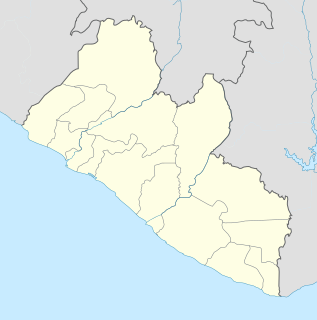
Samuel Kanyon Doe was a Liberian politician who served as the Liberian leader from 1980 to 1990, first as a military leader and later as a politician. Then Master Sergeant Doe served as chairman of the People's Redemption Council and de facto head of state after staging a violent coup d'etat in 1980; he killed President William R. Tolbert, Jr., and executed much of the True Whig Party leadership. Samuel Doe in turn was murdered by his conqueror, Prince Johnson, one time ally of Charles Taylor, in an internationally televised display.
Krahn is an ethnic group of Liberia and Ivory Coast. This group belongs to the Kru language family and its people are sometimes referred to as the Wee, Guéré, Sapo, or Wobe. It is likely that Western contact with the Kru language is the primary reason for the development of these different names. The term Krahn may also be applied to denote the language spoken by this ethnic group.
Prince Yormie Johnson is a Liberian politician and the current Senior Senator from Nimba County. A former rebel leader, Johnson played a prominent role in the First Liberian Civil War, in particular capturing, torturing, mutilating and executing President Samuel Doe, who had himself overthrown and murdered the previous president William R. Tolbert Jr.
The First Liberian Civil War was an internal conflict in Liberia from 1989 until 1997. The conflict killed about 250,000 people and eventually led to the involvement of the Economic Community of West African States (ECOWAS) and of the United Nations. The peace did not last long, and in 1999 the Second Liberian Civil War broke out.

The Economic Community of West African States Monitoring Group (ECOMOG) was a West African multilateral armed force established by the Economic Community of West African States (ECOWAS). ECOMOG was a formal arrangement for separate armies to work together. It was largely supported by personnel and resources of the Nigerian Armed Forces, with sub-battalion strength units contributed by other ECOWAS members — Ghana, Guinea, Sierra Leone, The Gambia, Liberia, Mali, Burkina Faso, Niger, and others.

Nimba County is a county in the northeastern Liberia that shares borders with the Republic of Côte d'Ivoire in the East and the Republic of Guinea in the Northwest. Its capitol city is Sanniquellie and its most populous city is Ganta. With the county's area measuring 11,551 square kilometres (4,460 sq mi), Nimba is the largest of Liberia's 15 counties. The county has 6 statutory districts and as of the 2008 Census, it had a population of 462,026, making it the second most populous county in Liberia.

Kangama is town in Kailahun District in the Eastern Province of Sierra Leone. It is the headquarters of the Kissi Teng Chiefdom.
The National Patriotic Front of Liberia (NPFL) was a rebel group that initiated and participated in the First Liberian Civil War from 1989 to 1996.

The Independent National Patriotic Front of Liberia (INPFL) was a rebel group that participated in the First Liberian Civil War under the leadership of Prince Johnson. It was a breakaway faction of the National Patriotic Front of Liberia (NPFL).
The Liberia Peace Council (LPC) was a rebel group that participated in the Liberian Civil War under the leadership of George Boley.

The United Nations Mission in Liberia (UNMIL) was a peacekeeping force established in September 2003 to monitor a ceasefire agreement in Liberia following the resignation of President Charles Taylor and the conclusion of the Second Liberian Civil War. The peacekeeping mission formally withdrew on 30 March 2018. At its peak it consisted of up to 15,000 United Nations military personnel and 1,115 police officers, along with a civilian component. It superseded the United Nations Observer Mission in Liberia (UNOMIL). As of July 2016, 1,240 U.N. military and 606 police personnel remained on the ground, but were there only in case of emergency.

River Cess is the capital city of Rivercess County, Liberia. As of the 2008 national census, the population stood at 2,578. It received its original name Cestos from Portuguese traders in the early 16th century from the baskets that were produced and sold in the town. Cestos in Portuguese and Spanish means basket.
The United Nations Peacekeeping began in 1948. Its first mission was in the Middle East to observe and maintain the ceasefire during the 1948 Arab–Israeli War. Since then, United Nations peacekeepers have taken part in a total of 72 missions around the globe, 14 of which continue today. The peacekeeping force as a whole received the Nobel Peace Prize in 1988.
John Mark Inienger (1945–2002) was a Nigerian Army major general who served as ECOMOG field commander in Liberia, governor of Bendel State between 1985 and 1987, during the military administration of General Ibrahim Babangida, and commander of the Brigade of Guards.

United Nations Security Council resolution 866, adopted unanimously on 22 September 1993, after reaffirming resolutions 813 (1993) and 856 (1993), the Council noted that United Nations involvement would contribute significantly to the effective implementation of the Peace Agreement in Liberia and went on to establish the United Nations Observer Mission in Liberia (UNOMIL).
United Nations Security Council resolution 950, adopted unanimously on 21 October 1994, after reaffirming resolutions 813 (1993), 856 (1993), 866 (1993) and 911 (1994), the Council noted the deteriorating situation in Liberia and extended the mandate of the United Nations Observer Mission in Liberia (UNOMIL) until 13 January 1995.

United Nations Security Council resolution 985, adopted unanimously on 13 April 1995, after reaffirming resolutions 813 (1993), 856 (1993), 866 (1993), 911 (1994), 950 (1994) and 972 (1995), and 788 (1992) which imposed an arms embargo on Liberia, the Council established a Committee to monitor the implementation of the embargo and extended the mandate of the United Nations Observer Mission in Liberia (UNOMIL) until 30 June 1995.
Major-General Abdul One Mohammed was military governor of Borno State, Nigeria, and later was leader of the ECOMOG peacekeeping force in Liberia and Sierra Leone.











